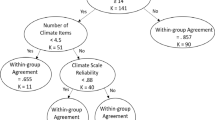Abstract
A great deal of research relating the work ethic to other individual difference variables has been conducted using questionnaires to measure all the variables. Many researchers believe that using a single method of measurement for multiple constructs results in artificially inflated correlations. A Confirmatory Factor Analysis of the work ethic, locus of control, and conscientiousness reveals that approximately 16% of the variance in measures of these constructs is a function of the method of measurement. This suggests that correlations in work ethic research based on only one method of measurement may be overstated.
Similar content being viewed by others
REFERENCES
Avolio, B. J., Yammarino, & Bass, B. M. (1991). Identifying common method variance with data collected from a single source: An unresolved sticky issue. Journal of Management, 17, 571–587.
Bagozzi, R. P., & Yi, Y. (1990). Assessing method variance in matrices: The case of self-reported affect and perceptions at work. Journal of Applied Psychology, 75, 547–560.
Barrick, M. R., & Mount, M. K. (1991). The Big Five personality dimensions and job performance: A meta-analysis. Personnel Psychology, 44, 1–26.
Barrick, M. R., & Mount, M. K. (1993). Autonomy as a moderator of the relationships between the big five personality dimensions and job performance. Journal of Applied Psychology, 78, 111–118.
Buckley, M. R., Cote, J. A., & Comstock, S. M. (1990). Measurement errors in the behavioral sciences: The case of personality/attitude research. Educational and Psychological Measurement, 50, 447–474.
Campbell, J. P. (1982). Editorial: Some remarks from an outgoing editor. Journal of Applied Psychology, 67, 691–700.
Cattell, R. B., Eber, H. W., & Tatsuoka, M. M. (1970). Handbook for the sixteen personality factor questionnaire. Champaign, IL: Institute for Personality and Ability Testing.
Digman, J. M. (1990). Personality structure: Emergence of the five-factor model. Annual Review of Psychology, 41, 417–440.
Furnham, A. (1984). The Protestant Work Ethic: A review of the psychological literature. European Journal of Social Psychology, 14, 87–104.
Furnham, A. (1990a). A content, correlational, and factor analytic study of seven questionnaire measures of the Protestant Work Ethic. Human Relations, 43, 383–389.
Furnham, A. F. (1990b). The Protestant Work Ethic: The psychology of work-related beliefs and behaviors. Routledge: London, England.
Lied, T. R., & Pritchard, R. D. (1976). Relationships between personality variables and components of the expectancy-valence model. Journal of Applied Psychology, 61, 463–467.
McCrae, R. R., & John, O. P. (1992). An introduction to the five-factor model and its applications. Journal of Personality, 60, 175–211.
Mirels, H. L., & Garrett, J. B. (1971). The Protestant ethic as a personality variable. Journal of Consulting and Clinical Psychology, 36, 40–44.
Mitchell, T. R. (1985). An evaluation of the validity of correlational research conducted in organizations. Academy of Management Review, 10, 192–205.
Motowidlo, S. J., Carter, G. W., Dunnette, M. D., Tippins, N., Werner, S., Burnett, J. R., & Vaughan, M. J. (1992). Studies of the structured behavioral interview. Journal of Applied Psychology, 77, 571–587.
Nunally, J. (1978). Psychometric Theory, New York: McGraw Hill.
Podsakoff, P. M., & Organ, D. W. (1986). Self-reports in organizational research: Problems and prospects. Journal of Management, 12, 531–544.
Roth, P. L., and McMillan, J. J. (1993). The behavior description interview. The CPA Journal, December, 76–79.
Rotter, J. B. (1966). Generalized expectancies for internal versus external control of reinforcement. Psychological Monographs, 80, (1 Whole No. 609).
Schmitt, N. (1994). Method bias: The importance of theory and measurement. Journal of Organizational Behavior, 15 393–398.
Waters, L. K., Batlis, N., & Waters, C. W. (1975). Protestant ethic attitudes among college students. Educational and Psychological Measurement, 35, 447–450.
Weber, M. (1958). The protestant work ethic and the spirit of capitalism (T. Parsons, Trans.). New York: Scribner's Sons.
Williams, L. J., & Brown, B. K. (1994). Method variance in organizational behavior and human resources research: Effects on correlations, path coefficients, and hypothesis testing. Organizational Behavior & Human Decision Processes, 57, 185–209.
Williams, L. J., Cote, J. A., & Buckley, R. M. (1989). Lack of method variance in self-reported affect and perceptions at work: Reality or artifact? Journal of Applied Psychology, 74, 462–468.
Windaman, K. F. (1985). Hierarchically nested covariance structure models for multitrait-multimethod data. Applied Psychological Measurement, 9, 1–26.
Author information
Authors and Affiliations
Rights and permissions
About this article
Cite this article
Roth, P.L., Hearp, C. & Switzer, F.S. The effect of Method Variance on Relationships Between the Work Ethic and Individual Difference Variables. Journal of Business and Psychology 14, 173–186 (1999). https://doi.org/10.1023/A:1022974921400
Issue Date:
DOI: https://doi.org/10.1023/A:1022974921400




